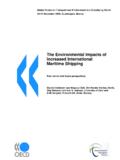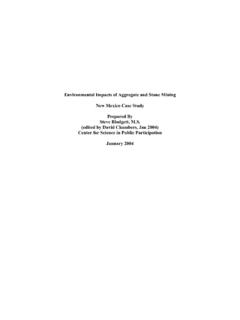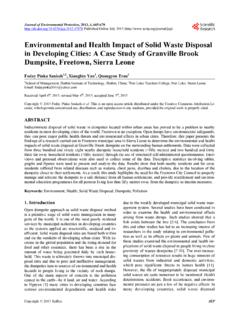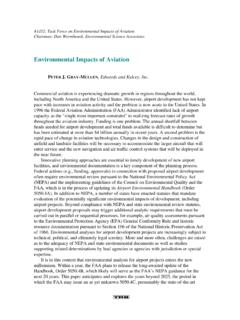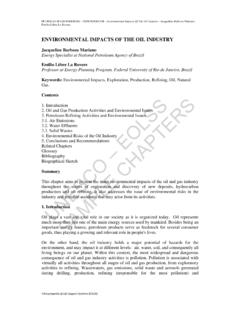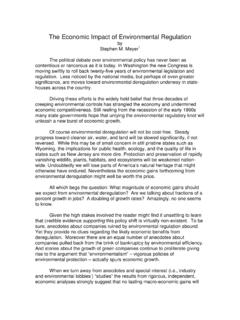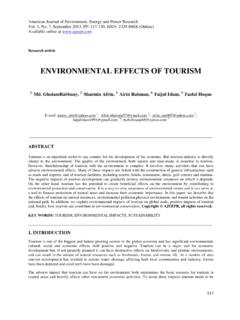Transcription of Office of Environment and Energy January 2015
1 Office of Environment and Energy January 2015 Aviation Emissions, Impacts & Mitigation: A Primer Aviation Emissions, Impacts & Mitigation A Primer FAA Office of Environment and Energy January 2015 Aviation & Emissions A Primer Table of Contents Introduction .. 1 Aviation 2 Emission Impacts .. 10 Mitigating Aviation Emissions .. 22 Conclusion .. 31 Abbreviations & Acronyms .. 33 End Notes .. 35 Aviation and the Environment : A Primer Introduction Transportation is an essential contributor to the health and well-being of the nation s economy. Within the transportation sector, commercial aviation has evolved into the fastest, safest, and most far-reaching transportation mode in little more than a century. The world economy benefits greatly from the ability to move people and products all over the globe - quickly and safely. The statistics are impressive. Today, over 3 billion people, nearly half the global population, use the world s The air transport industry provides 56 million direct, indirect, and induced jobs worldwide, which is double the number of jobs only eight years ago.
2 While aircraft carry only of world trade shipments, that represents about 35% of the value of all world This productivity is achieved consuming just of world Energy . 3 Aviation contributes to quality of life allowing us to visit friends and relatives, to travel, to experience new places, to shrink the world. Aviation must develop if it is to continue to meet the needs of a growing economy and an expanding population. At the same time, aviation must be environmentally sustainable, operating harmoniously within the constraints imposed by the need for clean air and water, limited noise impacts, and a livable climate. The Federal Aviation Administration (FAA) is working with other stakeholders to transform the aviation system to address the challenges and opportunities of the future. In July 2012, it published the Aviation environmental and Energy Policy Statement 4 which identifies and reaffirms FAA s commitment to environmental protection that allows sustained aviation growth.
3 The Policy Statement lists the guiding principles of: 1) limiting and reducing future aviation environmental impacts to levels that protect public health and welfare and 2) ensuring Energy availability and sustainability. FAA s Next Generation Air Transportation System (NextGen) will establish the programs, systems, and policies needed for safer, responsive, and more efficient air transport. The FAA s Office of Environment and Energy (AEE) is working to develop new technologies, operations, systems, and fuels to ensure aviation can meet the goals of NextGen while minimizing aviation s impact on the Environment . AEE has established a strategic framework to guide research programs for mitigating the environmental impacts of aviation. The framework calls for working with the environmental Protection Agency (EPA), the National Aeronautics and Space Administration (NASA), and other federal agencies as well as industry stakeholders and academia to ensure aviation emissions do not pose health concerns for citizens or degrade the global climate.
4 Aviation affects the Environment in many ways: people living near airports are exposed to noise from aircraft; streams, rivers, and wetlands may be exposed to pollutants discharged in storm water runoff from airports; and aircraft engines emit pollutants to the atmosphere. This primer describes the emissions associated with commercial aviation and the health and welfare impacts that can result from those aviation emissions that degrade not only air quality but also the broader climate. Noise5 and water quality6 considerations are not included in this report but are addressed in other FAA materials. 1 Aviation Emissions, Impacts & Mitigation: A Primer Aviation Emissions Aircraft, cars, trucks, and other vehicles operating at the airport create emissions as a result of the combustion of fuel as summarized in Table 1. Aircraft engines produce carbon dioxide (CO2), which comprises about 70% of the exhaust, and water vapor (H2O), which comprises about 30%. Less than 1% of the exhaust is composed of pollutants like nitrogen oxides (NOx), oxides of sulfur (SOx), carbon monoxide (CO), partially combusted or unburned hydrocarbons (HC), particulate matter (PM), and other trace compounds.
5 Generally, about 10 percent of aircraft pollutant emissions7 are emitted close to the surface of the earth (less than 3000 feet above ground level). The remaining 90 percent of aircraft emissions are emitted at altitudes above 3000 feet. The pollutants CO and HCs are exceptions to this rule as they are produced when aircraft engines are operating at their lowest combustion efficiency (while wheels are on the ground), which makes their split about 30 percent below 3000 feet, and 70 percent above 3000 Aircraft are not the only source of aviation emissions. Airport access and ground support vehicles typically burn fossil fuels and produce similar emissions. This includes traffic to and from the airport, shuttle buses and vans serving passengers, and ground support equipment (GSE) that services aircraft. Other common emissions sources at the airport include auxiliary power units (APU) providing electricity and air conditioning to aircraft parked at airport terminal gates, stationary airport power sources, and construction equipment operating on the airport.
6 Emission Formation and Transformation. Many of the pollutants that form in the combustion process transform when they are emitted to the atmosphere. Aircraft pollutants generally transform in three different zones: 1) immediately after exiting the combustor within the engine, 2) downstream from the engine in the hot exhaust plume, and 3) after emissions have cooled and mixed with the ambient atmosphere. At the aircraft engine exit, hot combustion gases mix with ambient air to quickly cool the gas stream. Some gases, like heavy hydrocarbons, can condense under these conditions to form aerosol particles. In the exhaust plume, as emissions continue to cool, some molecules undergo chemical reactions producing other molecules that can also condense into particles. Small particles in the plume collide and form larger particles, although still microscopic in size. The resulting PM in the plume can be solid or liquid and include carbon in the form of soot, inorganic salts (like ammonium nitrate and ammonium sulfate), and heavy hydrocarbons that condense into aerosol particles.
7 Likewise, gaseous and particle emissions from cars, trucks, and ground vehicles that have exhaust pipes, catalytic converters or particle traps, and mufflers, transform in the exhaust plume after mixing with the ambient atmosphere. Most of the aviation-related PM that reaches airport communities are particle emissions that are released during ground operations and landing and takeoff. Local communities are less affected by PM emissions from cruise operations. 2 Aviation Emissions, Impacts & Mitigation: A Primer Table 1: Aviation Emissions Emission Description Emission Sources Impacts CO2 Carbon dioxide is the product of complete combustion of hydrocarbon fuels like gasoline, jet fuel, and diesel. Carbon in fuel combines with oxygen in the air to produce CO2 Aircraft APU GSE Vehicles Stationary power plants Construction equipment Climate change H2O Water vapor is the other product of complete combustion as hydrogen in the fuel combines with oxygen in the air to produce H2O.
8 This is the source of water in condensation trails (contrails). Aircraft APU GSE Vehicles Stationary power plants Construction equipment Climate change NOx Nitrogen oxides are produced when air passes through high temperature/high pressure combustion and nitrogen and oxygen present in the air combine to form NOx. Contributes to ozone and secondary particulate matter formation. Aircraft APU GSE Vehicles Stationary power plants Construction equipment Air quality Climate change HC Hydrocarbons are emitted due to incomplete fuel combustion. They are often referred to as unburned hydrocarbons (UHC) or volatile organic compounds (VOCs) [VOC excludes some low reactivity compounds found in measures of HC9] Some of the compounds in the HC emissions are toxic and hazardous air pollutants (HAPs). Contributes to ozone formation. Aircraft APU GSE Vehicles Stationary power plants Construction equipment Air quality CH4 Methane is the most basic hydrocarbon.
9 Commercial aircraft are net consumers of methane during cruise and are not listed in the emissions source column. The net impact of methane from airport sources is highly dependent on local circumstances. APU GSE Vehicles Stationary power plants Construction equipment Air quality CO Carbon monoxide is formed due to the incomplete combustion of the carbon in the fuel. Contributes to ozone formation. Aircraft GSE Vehicles Construction equipment Air quality 3 Aviation Emissions, Impacts & Mitigation: A Primer SOx Sulfur oxides are produced when small quantities of sulfur, present in essentially all petroleum fuels, combine with oxygen from the air during combustion. Contributes to secondary particulate matter formation. Aircraft APU GSE Construction equipment Air quality Climate change Particulate Matter (non-volatile) Small particles of soot ( black carbon) that form as a result of incomplete combustion and aerosols from condensed gases, which are small enough to be inhaled, are referred to as particulate matter.
10 Discussed in detail in Health and environmental Effects Section. Aircraft APU GSE Vehicles Stationary power plants Construction equipment Air quality Climate change As aircraft and vehicle emissions mix with the ambient atmosphere, further chemical reactions occur. These reactions involve both molecules emitted from the aircraft and vehicle engines as well as molecules already in the air. For example, ozone is formed by the reaction of VOCs and NOx in the presence of heat and sunlight. Also, complex chemical reactions and/or particle nucleation processes can produce new particles or add to pre-existing particles. The subsequent particles that are formed can be an order of magnitude greater than primary particles10. These particles are estimated to represent more than 95% of total particle formation11 and expose people over a much broader geographic range. Other examples are the conversion of nitrogen dioxide (NO2) from the plume to nitric acid (HNO3) vapor that interacts with ammonia in the atmosphere and forms ammonium nitrate (NH4NO3) particles and oxidation reactions involving gaseous hydrocarbons from the plume, yielding condensable organic compounds that form organic aerosol particles.










